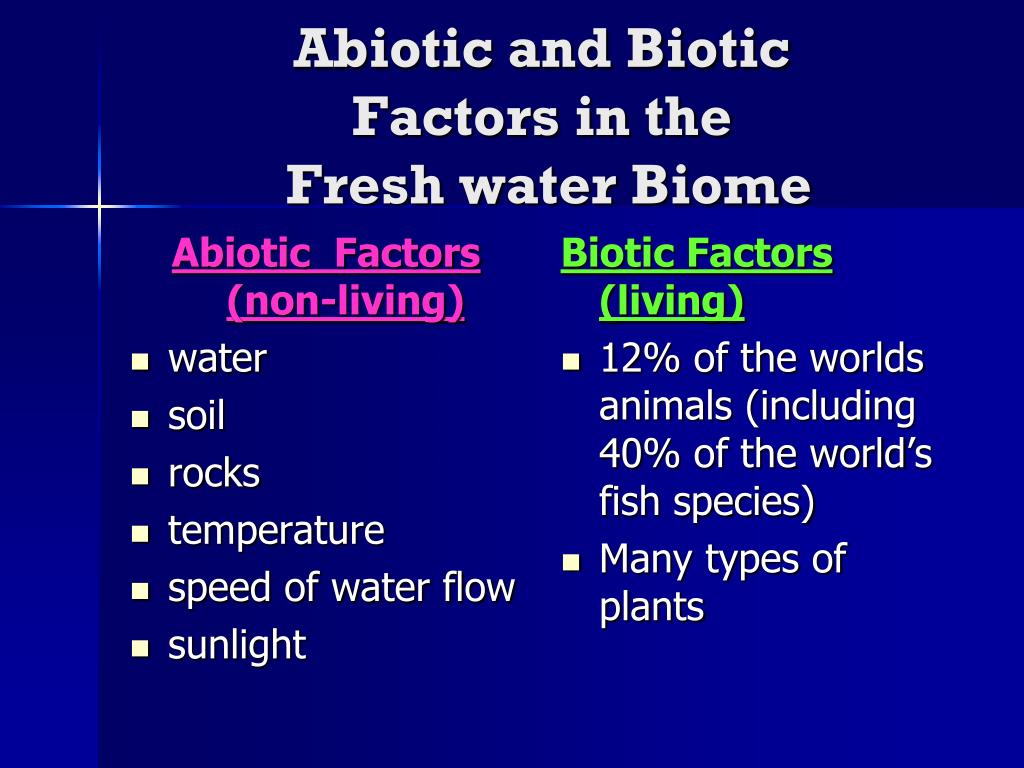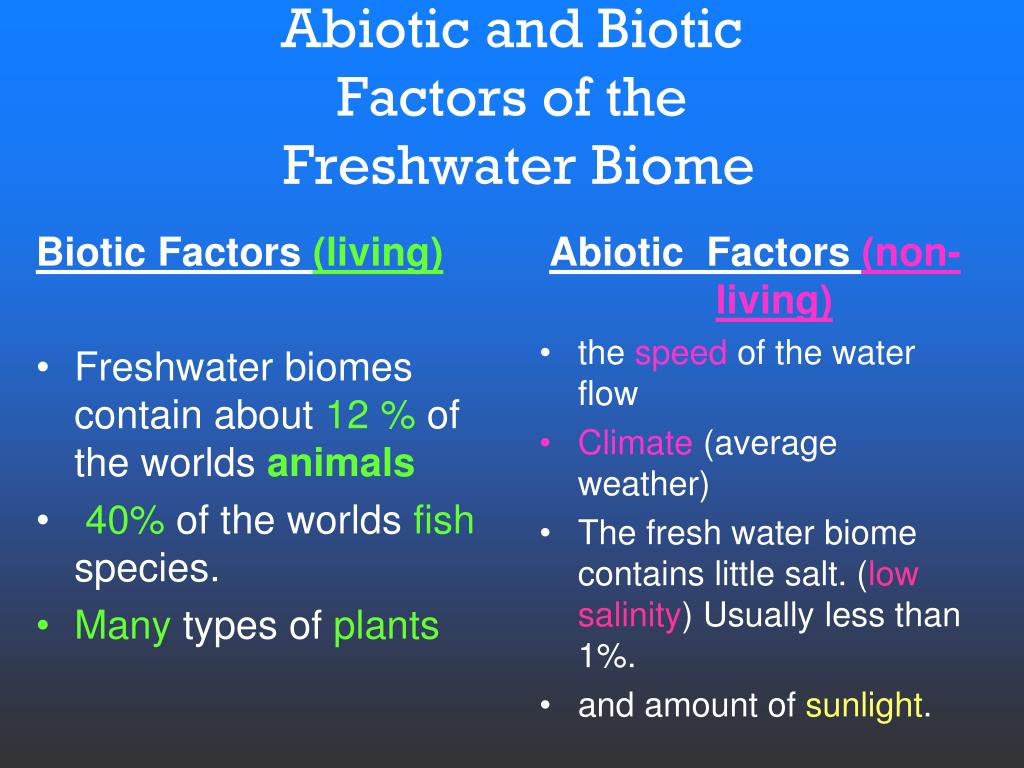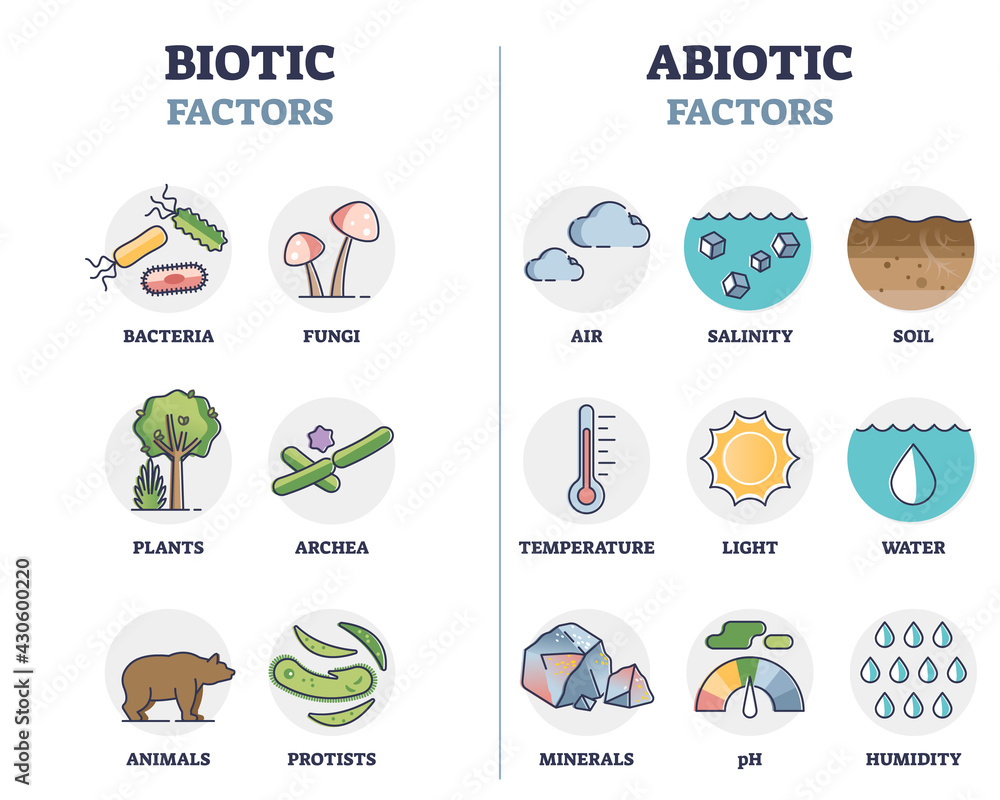Topic abiotic factors in a freshwater ecosystem: Explore the unseen forces shaping freshwater ecosystems through the lens of abiotic factors, from sunlight to water chemistry, and their pivotal roles in nurturing biodiversity.
Table of Content
- What are the abiotic factors in a freshwater ecosystem?
- Overview of Abiotic Factors
- Importance of Sunlight and Temperature
- Water Chemistry: pH, Oxygen, and Dissolved Gases
- Physical Characteristics: Flow Rate, Depth, and Turbidity
- Substrate Types: Sediments and Rocks
- Role of Nutrients in Freshwater Ecosystems
- YOUTUBE: Freshwater Ecosystems | Iken Edu
- Impact of Abiotic Factors on Biodiversity and Ecosystem Health
- Human Impacts on Freshwater Abiotic Factors
- Conservation and Management Strategies
- Case Studies: Examples of Freshwater Ecosystem Adaptations
What are the abiotic factors in a freshwater ecosystem?
Abiotic factors play a crucial role in determining the characteristics and functioning of a freshwater ecosystem. These non-living components have a direct impact on the organisms that inhabit the ecosystem. Some of the main abiotic factors in a freshwater ecosystem include:
- Water temperature: The temperature of the water affects the metabolism, reproduction, and overall survival of organisms. It can influence the rate of chemical reactions in the water.
- Water velocity: The speed at which water flows can determine which organisms can survive in the ecosystem. Some organisms are adapted to high flow rates, while others thrive in slower currents.
- Water pH: The pH level of the water indicates its acidity or alkalinity. Different organisms have specific pH requirements, and extreme levels can be detrimental to their survival.
- Oxygen concentration: Dissolved oxygen is essential for the survival of aquatic organisms. It is necessary for respiration and other metabolic processes.
- Nutrients: The availability of essential nutrients, such as nitrogen and phosphorus, influences the growth and productivity of plants and algae in the ecosystem.
- Light: Sunlight is a vital source of energy for photosynthesis in aquatic plants. The depth and clarity of the water determine the amount of light available for photosynthetic organisms.
- Substrate: The composition and texture of the substrate (bottom of the water body) can influence the types of organisms that can inhabit the ecosystem. Some organisms require sandy, rocky, or muddy substrates to survive.
These abiotic factors interact with each other and impact the biotic components of the ecosystem, including plants, animals, and microorganisms. Understanding these factors is crucial for ecosystem management and conservation.
READ MORE:
Overview of Abiotic Factors
Abiotic factors are the non-living components that shape freshwater ecosystems. These factors create the physical and chemical environment in which aquatic life exists. Understanding these elements is essential for grasping how ecosystems function and sustain diverse forms of life.
- Temperature: Influences metabolic rates of organisms and water density.
- Light: Essential for photosynthesis, affecting plant growth and oxygen production.
- Water Chemistry: Includes pH levels, dissolved oxygen, and nutrients which are crucial for life.
- Flow Rate: Affects sediment distribution and the availability of habitats.
- Substrate: The type of bottom (mud, sand, rock) influences the types of organisms that can live there.
- Nutrients: Nitrogen, phosphorus, and other elements are essential for growth and reproduction of aquatic plants and algae.
Together, these abiotic factors dictate the types of organisms that can thrive in freshwater environments, their distribution, and the overall health of the ecosystem.

Importance of Sunlight and Temperature
Sunlight and temperature are pivotal abiotic factors that profoundly influence freshwater ecosystems. They play a critical role in determining the physical conditions and biological activities within these habitats.
- Sunlight: Essential for photosynthesis, sunlight drives the production of oxygen and organic compounds, providing the energy base for aquatic food webs. The amount of sunlight penetrating water bodies affects the distribution of photosynthetic organisms and overall ecosystem productivity.
- Temperature: Regulates the biological processes of aquatic organisms, including metabolism, reproduction, and behavior. Temperature variations influence water density and stratification, which in turn affects oxygen levels and nutrient cycling. It also dictates the geographical distribution of species and seasonal dynamics within the ecosystem.
Together, sunlight and temperature shape the living conditions in freshwater ecosystems, facilitating diverse life forms while controlling the processes of growth, development, and decay. Their balance is essential for the health and sustainability of aquatic environments.
Water Chemistry: pH, Oxygen, and Dissolved Gases
The chemical composition of water in freshwater ecosystems, including pH, oxygen, and other dissolved gases, is crucial for maintaining life. Variations in these parameters can significantly impact the health and diversity of aquatic organisms.
- pH Levels: Measures the acidity or alkalinity of water. A balanced pH is vital for the survival of most aquatic species as it affects metabolic rates and the availability of nutrients and toxins. The optimal pH range for freshwater ecosystems usually falls between 6.5 and 9.0.
- Oxygen: Dissolved oxygen is essential for aerobic respiration in aquatic organisms. The concentration of oxygen in water is influenced by temperature, flow rate, and the presence of plants and algae. Oxygen levels can indicate the health of an ecosystem, with low levels often signaling pollution or eutrophication.
- Dissolved Gases: Besides oxygen, gases like nitrogen and carbon dioxide are dissolved in water. These gases are critical for plant photosynthesis and respiration in fish and other aquatic life. The balance of dissolved gases can be affected by temperature, pressure, and biological activity.
Monitoring water chemistry is essential for understanding and managing freshwater ecosystems, as it directly influences the biodiversity, productivity, and overall ecological balance.

Physical Characteristics: Flow Rate, Depth, and Turbidity
The physical characteristics of a freshwater ecosystem, including flow rate, depth, and turbidity, significantly affect its abiotic conditions and the organisms that inhabit it.
- Flow Rate: Determines the movement of water and the distribution of sediments, nutrients, and organisms. High flow rates can influence the types of species that can survive, favoring those adapted to stronger currents, while low flow rates may support a different set of organisms.
- Depth: Influences water temperature, pressure, and light penetration. Deeper waters tend to be cooler and have less light, affecting the types of plants and animals that can thrive. Depth also determines the stratification of water layers, impacting oxygen and nutrient distribution.
- Turbidity: Refers to the cloudiness or haziness of water caused by suspended particles. High turbidity can reduce light penetration, affecting photosynthesis in aquatic plants and visibility for predators and prey. It can also influence water temperature by absorbing more heat.
Understanding these physical characteristics is crucial for managing freshwater ecosystems and ensuring the diversity and health of aquatic life. They directly impact water quality, habitat suitability, and the ecological balance within these environments.
Substrate Types: Sediments and Rocks
The substrate of a freshwater ecosystem, consisting of sediments and rocks, significantly influences its biological community. This foundation provides habitat, influences water chemistry, and affects the availability of nutrients.
- Sediments: Comprising organic matter, clay, silt, sand, and gravel, sediments form the bottom layer of freshwater ecosystems. Their composition affects water clarity, plant growth, and the types of organisms that can burrow and feed in the substrate.
- Rocks: Rocks and boulders create diverse habitats. They offer surfaces for algae and microorganisms to attach, hiding spots for fish and invertebrates, and influence the flow and oxygenation of water.
Together, sediments and rocks shape the physical landscape of freshwater ecosystems, determining the distribution and abundance of aquatic life. Their characteristics, such as particle size, composition, and stability, play a crucial role in ecosystem dynamics.

Role of Nutrients in Freshwater Ecosystems
Nutrients, such as nitrogen and phosphorus, are fundamental to the health and productivity of freshwater ecosystems. They support the growth of aquatic plants and algae, which are at the base of the food web.
- Nitrogen: Essential for protein synthesis, nitrogen is a key component of amino acids. It enters water bodies through the breakdown of organic matter and from agricultural runoff.
- Phosphorus: Vital for energy transfer within cells, phosphorus plays a crucial role in ATP formation. It typically reaches freshwater systems from soil erosion and wastewater discharge.
- Limiting Nutrients: In many freshwater ecosystems, either nitrogen or phosphorus can be a limiting nutrient. When in short supply, they can restrict ecosystem productivity despite the abundance of other nutrients.
The balance of nutrients is critical; too little can limit growth, while too much can lead to eutrophication, a condition that degrades water quality and habitat health. Managing nutrient levels is therefore essential for maintaining the biodiversity and functionality of freshwater ecosystems.
Freshwater Ecosystems | Iken Edu
Dive into the mesmerizing world of freshwater! Discover the vibrant colors of exotic fish, the tranquility of flowing rivers, and the diverse ecosystem that thrives beneath the surface. Join us on this remarkable journey and witness the beauty and serenity of freshwater environments like never before.
Biotic and Abiotic Components of Aquatic Ecosystems
Immerse yourself in the wondrous realm of the aquatic kingdom! Marvel at the graceful movements of marine creatures, explore the breathtaking coral reefs, and witness the extraordinary underwater life found within the depths of our oceans. By watching this captivating video, you\'ll gain a newfound appreciation for the vastness and majesty of the aquatic world.
Impact of Abiotic Factors on Biodiversity and Ecosystem Health
Abiotic factors play a crucial role in shaping the biodiversity and health of freshwater ecosystems. These non-living components determine the viability of habitats for various species and influence the complex interactions within these environments.
- Temperature and Light: Regulate photosynthesis, affecting plant growth and the distribution of aquatic life. Temperature changes can shift species composition and lead to habitat loss for temperature-sensitive species.
- Water Chemistry: pH, oxygen levels, and dissolved nutrients directly impact the survival, reproduction, and distribution of aquatic organisms. Variations can lead to changes in species dominance and ecosystem productivity.
- Physical Characteristics: Flow rate, depth, and turbidity influence habitat structures, affecting the availability of resources and shelter for species. Alterations can disrupt the balance of aquatic communities.
- Nutrients: Nutrient levels are critical for the growth of algae and aquatic plants, which form the base of the food web. However, excessive nutrients can lead to eutrophication, reducing oxygen levels and biodiversity.
The interplay of these abiotic factors ensures the resilience and stability of freshwater ecosystems, but changes in these factors can significantly impact ecosystem health, leading to biodiversity loss and altered ecosystem services.

Human Impacts on Freshwater Abiotic Factors
Human activities profoundly impact the abiotic factors critical to freshwater ecosystems, often with significant ecological consequences. Understanding these impacts is crucial for mitigating damage and preserving aquatic biodiversity.
- Pollution: Chemicals, waste, and excessive nutrients from agriculture, industry, and urban runoff alter water chemistry, leading to eutrophication, decreased oxygen levels, and harm to aquatic life.
- Climate Change: Alters temperature and precipitation patterns, affecting water availability, increasing the frequency of extreme weather events, and disrupting the delicate balance of aquatic ecosystems.
- Water Withdrawal: For agriculture, industry, and domestic use can reduce water levels, affecting habitats, altering flow rates, and impacting the overall health of freshwater ecosystems.
- Land Use Changes: Deforestation, urbanization, and agriculture change the landscape, affecting runoff patterns, sedimentation rates, and the physical characteristics of water bodies.
- Dams and Water Diversions: Alter natural flow regimes, disrupt sediment transport, and fragment habitats, impacting species distribution and ecosystem functions.
Addressing these human impacts requires concerted efforts towards sustainable management practices, pollution control, and climate change mitigation to ensure the health and resilience of freshwater ecosystems.
Conservation and Management Strategies
Effective conservation and management of freshwater ecosystems require a comprehensive understanding of abiotic factors and their interactions with biotic components. Strategies aimed at preserving these ecosystems focus on maintaining or restoring natural processes and resilience.
- Water Quality Monitoring: Regular assessment of water chemistry, including pH, dissolved oxygen levels, and pollutants, to ensure the health of aquatic life.
- Restoration Projects: Rehabilitating degraded habitats, such as riverbanks and wetlands, to improve water filtration and support biodiversity.
- Regulation of Water Use: Implementing sustainable water use practices to prevent over-extraction and maintain natural flow regimes.
- Control of Pollutant Sources: Reducing industrial, agricultural, and urban runoff through better waste management and land-use practices.
- Climate Change Mitigation: Strategies to reduce greenhouse gas emissions and enhance ecosystem resilience to temperature and precipitation changes.
- Public Awareness and Education: Raising awareness about the importance of freshwater ecosystems and promoting community involvement in conservation efforts.
By adopting these strategies, we can ensure the long-term health and sustainability of freshwater ecosystems, protecting them for future generations while supporting their role in global biodiversity and human well-being.

READ MORE:
Case Studies: Examples of Freshwater Ecosystem Adaptations
Exploring real-world examples provides insight into how freshwater ecosystems adapt to various abiotic factors. These case studies highlight the resilience and complexity of aquatic environments in response to changing physical and chemical conditions.
- Adaptation to Temperature Variations: A study on the thermal tolerance of fish species in the Colorado River demonstrates how temperature influences species distribution and behavior.
- Response to Altered Water Flow: Research in the Mississippi River Basin reveals how modifications in river flow rate affect sediment transport and aquatic habitats, leading to shifts in species composition.
- Acidification Resilience: A case study of freshwater lakes in Scandinavia examines the impact of acid rain on water chemistry and how ecosystems have adapted through changes in species diversity and water purification processes.
- Nutrient Management Strategies: An investigation into the eutrophication of Lake Erie showcases efforts to reduce nutrient runoff, demonstrating the importance of integrated management strategies for ecosystem health.
These examples underscore the adaptability of freshwater ecosystems to abiotic stresses, while also highlighting the need for informed conservation practices to support their resilience.
Understanding abiotic factors in freshwater ecosystems is crucial for conservation efforts, ensuring the diversity and health of these vital habitats for future generations to cherish and sustain.







